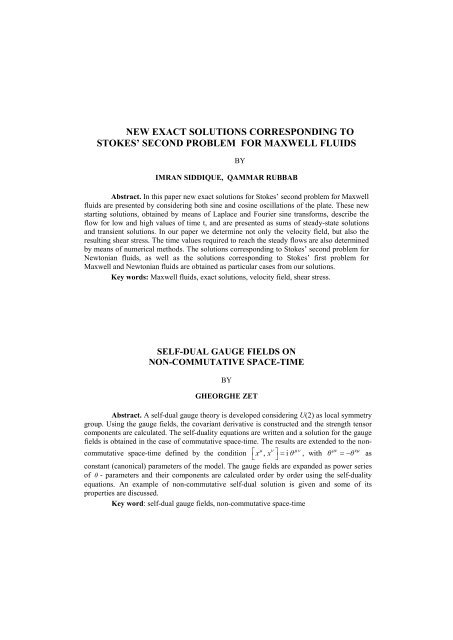buletinul institutului politehnic din iaşi bulletin of the polytechnic ...
buletinul institutului politehnic din iaşi bulletin of the polytechnic ...
buletinul institutului politehnic din iaşi bulletin of the polytechnic ...
- No tags were found...
You also want an ePaper? Increase the reach of your titles
YUMPU automatically turns print PDFs into web optimized ePapers that Google loves.
NEW EXACT SOLUTIONS CORRESPONDING TO<br />
STOKES’ SECOND PROBLEM FOR MAXWELL FLUIDS<br />
BY<br />
IMRAN SIDDIQUE, QAMMAR RUBBAB<br />
Abstract. In this paper new exact solutions for Stokes’ second problem for Maxwell<br />
fluids are presented by considering both sine and cosine oscillations <strong>of</strong> <strong>the</strong> plate. These new<br />
starting solutions, obtained by means <strong>of</strong> Laplace and Fourier sine transforms, describe <strong>the</strong><br />
flow for low and high values <strong>of</strong> time t, and are presented as sums <strong>of</strong> steady-state solutions<br />
and transient solutions. In our paper we determine not only <strong>the</strong> velocity field, but also <strong>the</strong><br />
resulting shear stress. The time values required to reach <strong>the</strong> steady flows are also determined<br />
by means <strong>of</strong> numerical methods. The solutions correspon<strong>din</strong>g to Stokes’ second problem for<br />
Newtonian fluids, as well as <strong>the</strong> solutions correspon<strong>din</strong>g to Stokes’ first problem for<br />
Maxwell and Newtonian fluids are obtained as particular cases from our solutions.<br />
Key words: Maxwell fluids, exact solutions, velocity field, shear stress.<br />
SELF-DUAL GAUGE FIELDS ON<br />
NON-COMMUTATIVE SPACE-TIME<br />
BY<br />
GHEORGHE ZET<br />
Abstract. A self-dual gauge <strong>the</strong>ory is developed considering U(2) as local symmetry<br />
group. Using <strong>the</strong> gauge fields, <strong>the</strong> covariant derivative is constructed and <strong>the</strong> strength tensor<br />
components are calculated. The self-duality equations are written and a solution for <strong>the</strong> gauge<br />
fields is obtained in <strong>the</strong> case <strong>of</strong> commutative space-time. The results are extended to <strong>the</strong> noncommutative<br />
space-time defined by <strong>the</strong> condition ⎡<br />
µ ν µν<br />
x , x ⎤<br />
µν νµ<br />
⎣ ⎦<br />
= i θ , with θ = − θ as<br />
constant (canonical) parameters <strong>of</strong> <strong>the</strong> model. The gauge fields are expanded as power series<br />
<strong>of</strong> θ - parameters and <strong>the</strong>ir components are calculated order by order using <strong>the</strong> self-duality<br />
equations. An example <strong>of</strong> non-commutative self-dual solution is given and some <strong>of</strong> its<br />
properties are discussed.<br />
Key word: self-dual gauge fields, non-commutative space-time
















